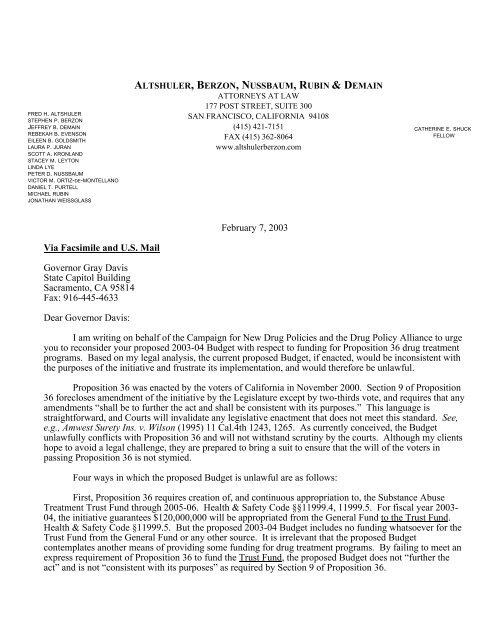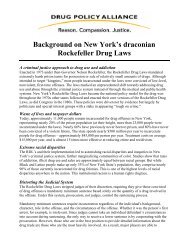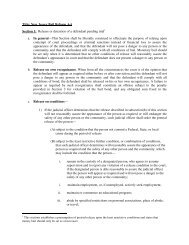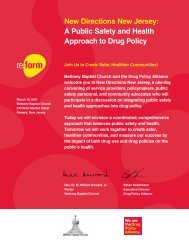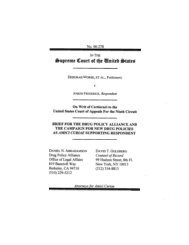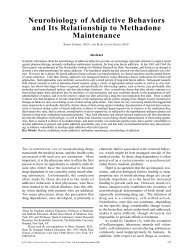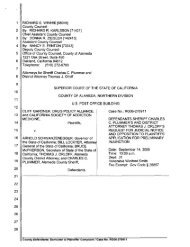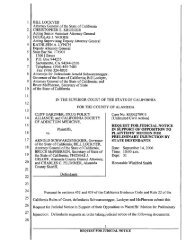Joint Letter to Gov. Davis, Senate Pres. Burton, Speaker Wesson ...
Joint Letter to Gov. Davis, Senate Pres. Burton, Speaker Wesson ...
Joint Letter to Gov. Davis, Senate Pres. Burton, Speaker Wesson ...
You also want an ePaper? Increase the reach of your titles
YUMPU automatically turns print PDFs into web optimized ePapers that Google loves.
Signers <strong>to</strong> <strong>Letter</strong> <strong>to</strong> <strong>Gov</strong>. <strong>Davis</strong>, Sen. Bur<strong>to</strong>n, <strong>Speaker</strong> <strong>Wesson</strong>Opposing Proposition 36 RealignmentINDIVIDUALS BY AFFILIATION (continued)Turning Point Homeless InterventionSteve Leinfus, Rancho CordovaRichard Cook, Santa RosaBrenda Lante, Santa RosaMark Fort, Santa RosaHarlan Moore (Prop 36 Client), SantaRosaVietnam Veterans of CaliforniaPeter Cameron, Santa RosaWoman With a Dream – OaklandGeorge JacobsonUSC - California Hospital – L.A.Maurene S<strong>to</strong>hm, MDUSC - Family Program – L.A.Condessa Curley, MD, MPUSC Hospital Medical Center – L.A.Sandra Wong, DOVA Medical Center – San FranciscoJennifer RoseINDIVIDUALSDonna Brown, Hep C Counselor, OaklandCynthia Cos, NNCLA Case Manager, L.A.Clyde Darring<strong>to</strong>n, Certified Community Outreach Worker, VallejoFlorence Hor<strong>to</strong>n, Recovery 25 yrs., Sacramen<strong>to</strong>Kelly Johnson, Veteran, Sacramen<strong>to</strong>Glenda Kelmes, University of California, IrvineMaria Kerbleshi, NCSGNA, San FranciscoLarry Peicho<strong>to</strong>, Hep C Counselor, HanfordDarrell Strickland, Certified Counselor, HaywardMartha Williams, OaklandNote: Individuals listed by affiliation for identification purposes only. Page 3Organizations that have formally joined opposition <strong>to</strong> realignment listed separately.
<strong>Gov</strong>ernor Gray <strong>Davis</strong>February 7, 2003Page 2Second, Proposition 36 provides that the State Department of Alcohol and Drug Programs (“ADP”)is <strong>to</strong> distribute Trust Fund monies <strong>to</strong> the counties using a formula developed by ADP based on fac<strong>to</strong>rs setforth in the initiative and further permits ADP <strong>to</strong> withhold a portion of the funds from the counties and giveit directly <strong>to</strong> service providers. Health & Safety Code §11999.6. The proposed Budget, however, providesdrug treatment money directly <strong>to</strong> counties as part of your “realignment” plan, thereby bypassing ADP. Thisproposal again conflicts with express provisions of Proposition 36 that require ADP <strong>to</strong> distribute the fundsaccording <strong>to</strong> an ADP-developed formula and permit ADP <strong>to</strong> give money directly <strong>to</strong> service providers.Third, Proposition 36 guarantees funding for drug treatment programs in two ways: The initiativerequires an appropriation of $120,000,000 <strong>to</strong> the Trust Fund, and further provides that no funds distributedfrom the Trust Fund may be used <strong>to</strong> “supplant funds from any existing fund source” for drug treatment.Health & Safety Code §11999.6. In other words, the initiative requires drug treatment funding in theamount of $120,000,000 plus existing funds that may not be decreased due <strong>to</strong> the anti-supplantationlanguage. (In addition, Health & Safety Code §11999.5 requires the unspent portion of each year’s TrustFund allocation <strong>to</strong> remain in the Trust Fund for future use.) Under realignment, there is nothingguaranteeing direct distribution <strong>to</strong> the counties of even the $120,000,000. Moreover, it appears that anymoney intended for Proposition 36 drug treatment programs will be provided <strong>to</strong> counties along with fundsfor other programs such as mental health and there will be no method of requiring the counties <strong>to</strong> spendmoney on Proposition 36 programs. Additionally, because the anti-supplantation language applies only <strong>to</strong>funds distributed from the Trust Fund, the realignment proposal would circumvent the anti-supplantationclause and permit the money going directly <strong>to</strong> counties <strong>to</strong> be used <strong>to</strong> supplant existing funds. By failing <strong>to</strong>guarantee drug treatment funding of $120,000,000 plus existing funds, the proposed Budget would violatethe language of Proposition 36 guaranteeing funding and instead permit substantial decreases in funding fordrug treatment programs, thereby conflicting with the purposes of the initiative.Fourth, Proposition 36 expressly provides for an oversight role by ADP <strong>to</strong> (i) provide up <strong>to</strong> 0.5percent of the Trust Fund for a long-term evaluation by a California university of the effectiveness andfinancial impact of Proposition 36 programs pursuant <strong>to</strong> Health & Safety Code §11999.10; (ii) itself conductan annual study of the programs under Health & Safety Code §11999.9; and (iii) conduct an annual audit ofexpenditures made by counties and require counties <strong>to</strong> repay <strong>to</strong> ADP misspent funds pursuant <strong>to</strong> Health &Safety Code §11999.12. These provisions provide the information necessary <strong>to</strong> decide how best <strong>to</strong> allocatedrug treatment money and hold counties accountable for the money they receive. Under the proposedBudget, ADP has stated that it will be unable <strong>to</strong> conduct its oversight responsibilities. As there will be noTrust Fund, ADP will be unable <strong>to</strong> allocate any money from the Trust Fund as required <strong>to</strong> fund the longtermevaluation. ADP has indicated that there is no other money available for the long-term evaluation.Similarly, there is no money for the annual study or audit. The inability of ADP <strong>to</strong> fulfill these mandatedresponsibilities is again in conflict with Proposition 36.In addition <strong>to</strong> these unlawful conflicts with Proposition 36, there is ample practical reason <strong>to</strong> excludedrug treatment funds from realignment. Two are of particular importance. First, regardless of the level offunding provided for drug treatment programs, the sentencing provisions of Proposition 36 will still requirediversion from prison. It makes no sense <strong>to</strong> “sentence” offenders <strong>to</strong> non-existent or barely functioning drugtreatment programs, thereby providing no deterrent <strong>to</strong> drug crimes and no rehabilitation for drug offenders.Second, the loss of the long-term evaluation promises <strong>to</strong> be devastating <strong>to</strong> the State’s ability <strong>to</strong> determinehow <strong>to</strong> fund drug treatment programs once Proposition 36 funding expires in 2006. The whole point ofProposition 36 was <strong>to</strong> provide a guaranteed amount of money for several years, evaluate the use of thatmoney, and then allow the Legislature and the <strong>Gov</strong>ernor <strong>to</strong> decide how much <strong>to</strong> spend in the future. Theabsence of a long-term evaluation will completely undermine the ability of elected officials <strong>to</strong> know whatworked and what did not, and therefore what <strong>to</strong> fund and in what amounts.
<strong>Gov</strong>ernor Gray <strong>Davis</strong>February 7, 2003Page 3Thank you for taking in<strong>to</strong> account the views of the Campaign for New Drug Policies and the DrugPolicy Alliance on the Budget. My clients hope that changes will be made <strong>to</strong> the current proposal now sothat they will not need <strong>to</strong> bring a lawsuit <strong>to</strong> force those changes later. We would appreciate an opportunity<strong>to</strong> meet with the appropriate representative from your office <strong>to</strong> discuss these issues.Sincerely,cc: Barry Goode, Legal Affairs SecretaryJonathan Weissglass


